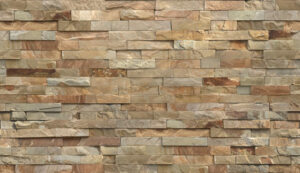Concrete Stonefacing is an excellent alternative to complete masonry stone for walls near swimming pools and hot tubs. It’s moisture and temperature-resistant and can be installed on new block or wood-frame walls with wall ties.

You’ll want to use a mortar with a low compressive strength compared to your masonry units for the best look. This will allow the mortar to absorb the stone’s texture.
Before installing stone veneer it is important to understand the surface preparation process. This is no different whether you are applying the stone to a block, poured concrete or wood-frame wall. For a wood-frame wall the proper support must be provided with a footing and the walls should be attached to the studs with either a powder actuated nail gun or masonry screws, and a weather resistant barrier such as a peel and stick roofing membrane or #30 felt paper must be applied to the exterior sheathing. If you are building a new wall or retrofitting an existing one, the walls must be reinforced with steel and the studs must be covered with a metal lath that is galvanized. The lath is then stapled to the studs with a staple gun using masonry nails.
The concrete or mortar used for stone facing must be mixed thoroughly and may need color added to create the desired look of natural stone. A water soluble release agent such as GlobMarble can be added to the concrete prior to pouring to help in the removal of the casting from the mold. Oxide pigments in a wide variety of earth tones such as brick reds, browns, ochers and umber are available and can be sprinkled and smudged into the wet concrete during mixing for a mottled appearance.
It is important not to apply too much pressure when setting the stones, as this can damage and weaken the cement. For a good bond, the back of each stone should be thoroughly dampened with clean water and then pressed into the scratch coat. Once the stone is set it is recommended to allow a few hours for curing before scratching the excess mortar from the back of the stone. Scratching too soon can smear the cement on the edges of the stone and compromise the integral structure of the mortar bed beneath it.
It is also very important not to attempt to clean any wet mortar dropped on installed stone until it is dry, as this can cause the wet mortar to spread and stain the stone. If you must remove any wet mortar before it dries, use a soft brush and masonry cleaner to remove any residue without damaging the stone.
Scratch Coat
When installing stone veneer you can often skip the use of a scratch coat on a block or cmu wall but if you are working on a concrete wall it is imperative. It may seem counterproductive to apply a thicker mud to the surface you are going to cover with stone but it helps in the long run by ensuring your veneer stones stick. It is also a great way to roughen up the surface which will make the brown coat application of your overlayment much easier.
The texture of the scratch coat creates a mechanical key that allows the subsequent brown coats (or plaster, mortar or concrete) to lock into it, creating a stronger bond. In addition, some types of scratch coats can help in the chemical bonding process by including additives or bonding agents that will react with the brown coat and allow a stronger adhesion between them.
Before the scratch coat has been applied it is important to wet down the wall and let it settle for a few minutes. Then you can begin to trowel it on or spray it on, whichever is easiest for your installation. Be sure to maintain a 3/8″ thick coat throughout the entire process.
This is the time to add color if you wish, dry pigment powders are available in many earth tones and can be added to the mix a little at a time. The more you add the more intense or variegated your color will become.
For a more uniform color, you can back butter the stone to build a bond coat. This is done by placing a dollop of mortar on the back side of the stone i.e. the side that will be pressed into the scratch coat. It is important to back butter all the corners of the stone as well.
When you are finished laying out your stone, take the opportunity to inspect each piece for size, shape and color to ensure a consistent pattern for your installation. It is also a good idea to try and stagger the corner pieces slightly in order to avoid long unbroken lines that can draw attention to themselves.
Metal Lath
Metal lath is a lightweight base to support plaster or stone veneer applications over a wall, soffit or ceiling. It is available in a wide variety of configurations such as self-furring expanded dimpled metal lath, flat-ribbed and wire mesh to meet project requirements and plaster/stucco preferences. It consists of a sheet of metal that has been slit and expanded into numerous diamond openings to provide an irregular surface for the keying of plaster or stucco. Without this type of surface, plaster and/or stucco would crack under the types of stress and deflation that occur throughout construction and residential living.
For framed exterior walls, a moisture control barrier should be applied over the sheathing before applying the metal lath. Once the lath is installed, it should be fastened using galvanized staples or nails 6 inches on center vertically and 16 inches on center horizontally, making sure to penetrate the studs at least 1 inch. For interior framed walls, a paper-backed version of the metal lath can be used to eliminate the need for a separate moisture control barrier, which may help reduce installation time.
During the lath process, a scratch coat is also applied to the wall using a mixture of 1 part type S masonry cement to 2.5 parts sand. This mixture is dry mixed and stirred thoroughly to avoid clumps. Water is then added a little at a time, mixing until it is the consistency of a paste.
If desired, dry pigment can be added to the mix prior to pouring concrete for a colored concrete wall. This allows for a mottled look to the finished product. Pigments are available in a wide array of earth tones – brick reds, browns, ochers and umber. They can be sprinkled and smudged onto the mold during mixing for a random look or they can be hand rubbed in with a rag. For a textured finish, the surface of the molded concrete can be scored with a wire brush before drying. This will cause the concrete to roughen up a bit and allow for the mortar to grip better.
Veneer Placement
When it comes to stone veneer installations, there are many factors that come into play. Some of them, like building codes and material selections, are mandated by your local government. Others, however, are more in the realm of professional judgment. For example, whether to use a wet or dry installation process or to use a weather resistant barrier and other detailing. While these details may seem minor, they can make the difference between a successful and problematic project.
Manufactured stone veneer (MSV) is a popular choice for homeowners and builders looking to add a natural aesthetic to their home without breaking the bank on full-scale stones. As such, this type of product must be installed properly for its long-term performance and durability.
To ensure a proper install, it is important to begin the project with a moisture barrier, even if you are installing on a concrete or masonry wall. In this case, the barrier should be applied to the sheathing or cladding of the wall rather than directly to the studs. This detail allows for a drainage plane and prevents moisture from soaking into the wood framing of the home, which can lead to rot and mold issues.
Once the sheathing is prepared, if you are using metal lath, a scratch coat should be applied. This is necessary to allow the mortar to grab onto the lath and provide a strong bond. This will also help eliminate the potential for unsightly sagging and other issues that can result from a direct installation on a wood frame.
When it comes time to begin placing the stone veneer, it is important that you do a “dry layout” before applying the actual mortar. This will allow you to determine how much stone you need and to check that the pieces are evenly sized. It is also a good opportunity to test your dry-stacking skills and ensure that you can create tight, natural-looking joints between the stones.
During the dry layout, it is important to pay attention to the color of the stone and make sure that there are no areas where the mortar will be visible between the pieces of veneer. If this is not the case, you will need to back butter the stone to build a bond and hide the mortar. Back buttering is an easy step that will ensure a clean, finished look for your stone veneer.


